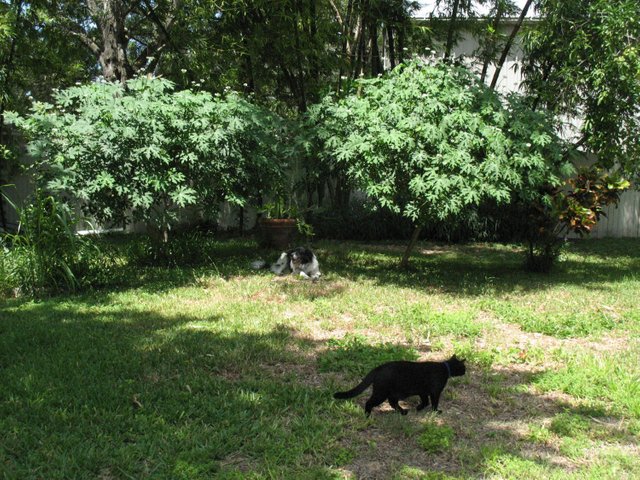
One of my primary reasons for wanting to start our mini-organic farm is that, since childhood, I have loved orchards and nurseries, and was lucky to be raised by a mom who had a serious thing for fruit and nut trees.
In our back yard in the Monterey Highlands, a suburban neighborhood of the Greater Los Angeles area, we grew up enjoying a variety of perennial fruit and vegetables, including Meyer lemons, natal plums, peaches, nectarines, loquats, strawberry guavas, asparagus, artichokes, strawberries, and undoubtedly several more that are simply not coming to mind at the moment.
My mother even planted a macadamia nut tree, but it was just getting old enough to start bearing when we moved across town, so we never got a crop from it, and sadly, I understand that the new owners cut down many of the fruit trees to put in a swimming pool. They also covered the gorgeous hardwood floors with wall-to-wall carpet. Sigh.
From that point forward, we lived in a succession of apartments and duplexes that didn't really allow for in-ground gardening, so we had to make do being avid container gardeners, which we certainly were. It wasn't until 1999, when my then-husband and I bought our house in Largo, Florida, that I was able to garden in the ground once again, though I still kept a lot of my plants in containers.
That house was initially purchased to house my husband's business, but what I loved about it from the start was the yard, and the lush plantings already in place, such as the giant bamboo.
There were also four citrus trees; two pink grapefruit trees, one yellow grapefruit tree, and a small Persian lime tree. The three grapefruit trees were large, mature, and bore an impressive amount of excellent fruit each winter. Only the Persian lime was an underachiever, and ultimately gave up the ghost a couple of years after we bought the place.
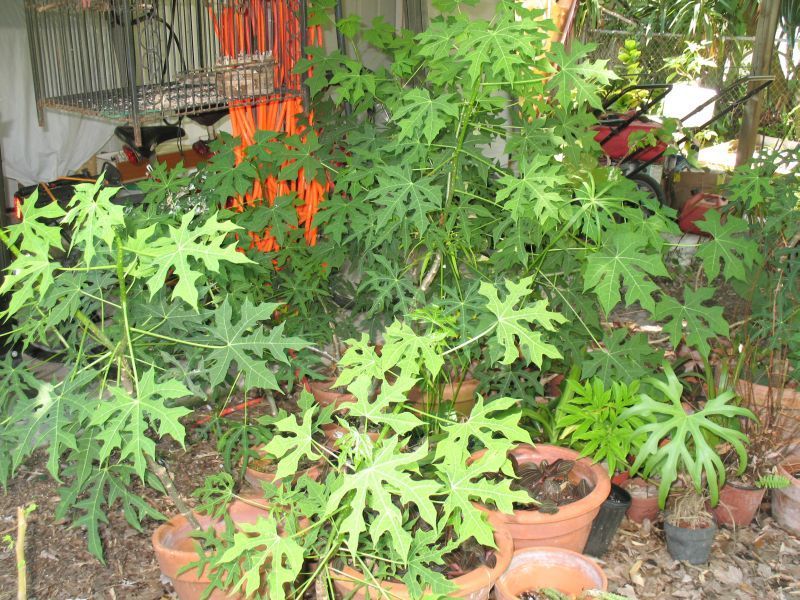
I immediately befriended our next-door neighbors Bud and Bette upon moving in, and Bette and I hit it off immediately, as she was a fellow plant lover and avid gardener. Like my grandmother, she had been a plant judge for 26 years, and since she was born in the same year as my mother, and raised on her parents' Saint Petersburg citrus farm, she was a wealth of information about the area, whether plant-related or not.
As just one example, I had always thought that Arneeda, the woman who owned the house before we bought it, had spent years improving the soil, to give us the deep black earthworm-rich soil with which we were blessed, so unlike the white sugar sand I had dealt with everywhere else I had lived in Tampa Bay.
But no, as Bette corrected me, our whole section of small block-long streets, just west of Starkey off the north side of Ulmerton Road, had once been a stock pond for a dairy farm, which had existed there for decades. This explained both the richness of our soil and its propensity for flooding quickly in heavy rains.
It was Bette who got me involved in the Rare Plant Network, which met monthly in a local Baptist church near where we lived, and through them I greatly expanded my collection of rare and unusual plants, edible and otherwise. If they are still around, I highly recommend them to gardeners in the Tampa Bay area, as a great resource and a group of truly nice and knowledgeable people.
It was also Bette who gave me my first chaya cutting, beginning my love affair with the plant that continues to this very day. We traded all sorts of plants back and forth on a regular basis, and I learned an immense amount from her, as she was a fountain of knowledge regarding what and how to grow in our particular soil and climate.
It was only a matter of time before I started a mini back yard nursery, since plant propagation has long been a hobby of mine, and I started growing way more vegetable and herb plants than I would ever use, and selling the extras. I also sold tree seedlings, seeds, cuttings and decorative planters with several plant varieties, all grown organically, and most of them were heirloom varieties.
My heirloom tomato and herb starts alone were a huge hit, not to mention ornamentals such as orchid cactus, bromeliads and begonias, and I sold out every spring.
Keep in mind that this was all accomplished on a small piece of land, just under a quarter of an acre, in a corner of my back yard, in my spare time. Any gardener, homesteader, farmer or permaculturist can do the same, and it can make for a great side income stream, not to mention a truly fun and gratifying hobby. And you,'ll never be lacking for lovely gifts for nearly any occasion.
CHAYA, aka CHAYAMANSA, aka TREE SPINACH
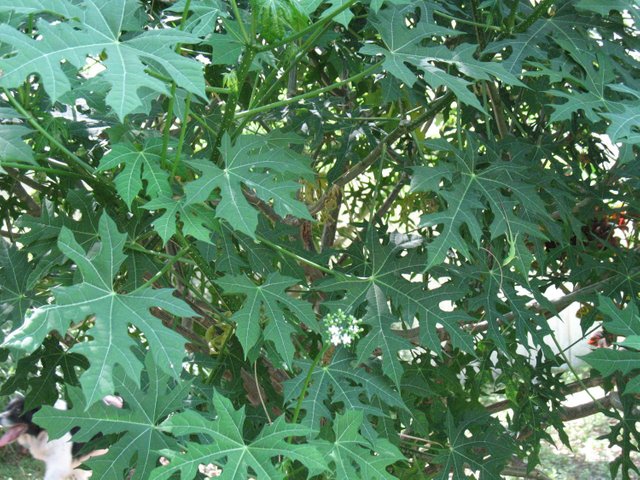
Back to chaya, which is one of the single most nutritious and prolific sources of green leafy vegetables you can grow. Chaya is native to the Yucatan Peninsula of Mexico, and adjacent areas of Central America, and was a staple food of the Mayan civilization, prior to the arrival of the Spaniards.
It can be used any recipe that calls for spinach, with the caveat that it must be cooked before you eat it, similar to cassava greens, as the leaves contain a mild toxin that is destroyed by cooking. Some people do eat the small, new leaves without cooking them, but is generally not recommended.
Chaya is also medicinal, and in Mexico it is often served as a tonic tea, which benefits the health in numerous ways. The larger leaves can be blanched quickly in boiling water, then used as wraps, similar to grape leaves. They can also be dried and powdered, then added to smoothies, soups, stews, meatloaf . . . anywhere where you want an extra dose of nutrition.
The young shoots (tips of branches) are also used similarly to asparagus; I usually slice them into soups, though to me, they taste nothing like asparagus. The taste is much milder and less distinctive.
Finally, you can blanch the leaves for a minute in boiling water, and season and dehydrate them for “chaya chips,” similar to kale chips, which are wonderful. Yum!
Tolerant of both flooding and drought, chaya was among the hot-weather spinach substitutes studied by the University of the Caribbean, in Jamaica, and they found that it was by far the most prolific plant they studied, as well as one of the most nutritious. Although I have tried several times to contact the university for more information, as of this writing, they have yet to respond.
Chaya is such a useful plant that it is now grown, and has naturalized, all over the tropics, is grown in many arid desert regions, such as sub-saharan Africa and the Middle East, and is all over the Caribbean, South and Central Florida and Texas.
Even better, because it very rarely sets viable seed, it is non-invasive, as it reproduces almost exclusively vegetatively, through cuttings, or by rooting when a portion of a bush is blown down or breaks off.
My older sister is a Master Gardener who lives in suburban Houston, Texas, and she and I agree that, if it were grown more widely, chaya could end world hunger almost singlehandedly. One large plant, once fully established, can provide virtually all the leafy greens needed for a couple. Two bushes could feed a family of four to six easily. A hedge can feed a neighborhood block. A large hedge can feed a LOT of people.
From that one cutting from Bette, within a couple of years my chaya was over six feet tall and roughly three feet wide, in a one-gallon nursery pot. I neglected to repot it the first season, and it rooted so strongly into the ground that I couldn't get it to budge.
It finally blew over in a bad thunderstorm, and broke into several pieces, at which point I planted four large branches in the ground. By a couple of years later, I jokingly started referring to them as the plants that ate Largo, and Marek and I joked that it was a good thing they weren't triffids – they were freaking HUGE!!! They averaged eight to ten feet tall, and roughly that wide, with no signs of slowing down, and this was with me cutting them back and harvesting the leaves on a regular basis.
Please note that, in the first photo above, that is not a tiny dog lying beneath the chaya bushes, but our 110-pound Newfoundland mix, Sprinkles. Those bushes are a good 10 to 12 feet tall in this photo.
And the bushes just kept on growing after this photo was taken. Once they are well-established, cutting them back spurs new growth, and if needed, you can harvest as much as 50% of the leaves at one time without harming the plant. Naturally, after such a drastic harvest, you would need to wait until the plant recovered before harvesting more.
It is not uncommon, in Tampa Bay and elsewhere in Florida and the Gulf Coast where freezes are rare, to see large specimens in peoples' yards. I always find myself hopeful that they are actually using it for food, and not just admiring its beauty . . . because it is a truly beautiful plant, with striking dark green maple-like foliage, that has few pests.
What's not to love?
It's flowers are beloved of bees and butterflies, and between the chaya and my grapefruit trees, we had an amazing number and variety of butterflies visiting our yard every year. In fact, one of the things I absolutely loved about our chaya bushes was that, in hot weather, they were the preferred afternoon resting spot for our multitudes of tiny copper-colored tree frogs, and as hard as our modern world is on amphibians, I was always grateful that they had a good hiding place available.
I also learned from Bette that chaya is a great forage plant for poultry, when she mentioned that her son kept ducks, and they kept his chaya stripped of leaves as high as they could reach. He regularly cut branches off and threw them to the hens, which are rich in calcium, and are said to increase egg production.
So far, our deer have left them alone, when I have had them outside. So did our goats, on the two occasions when they escaped the barnyard, and ravaged my prized plants that I had next to and on the front porch of our studio. They ate pretty much everything EXCEPT the chaya.
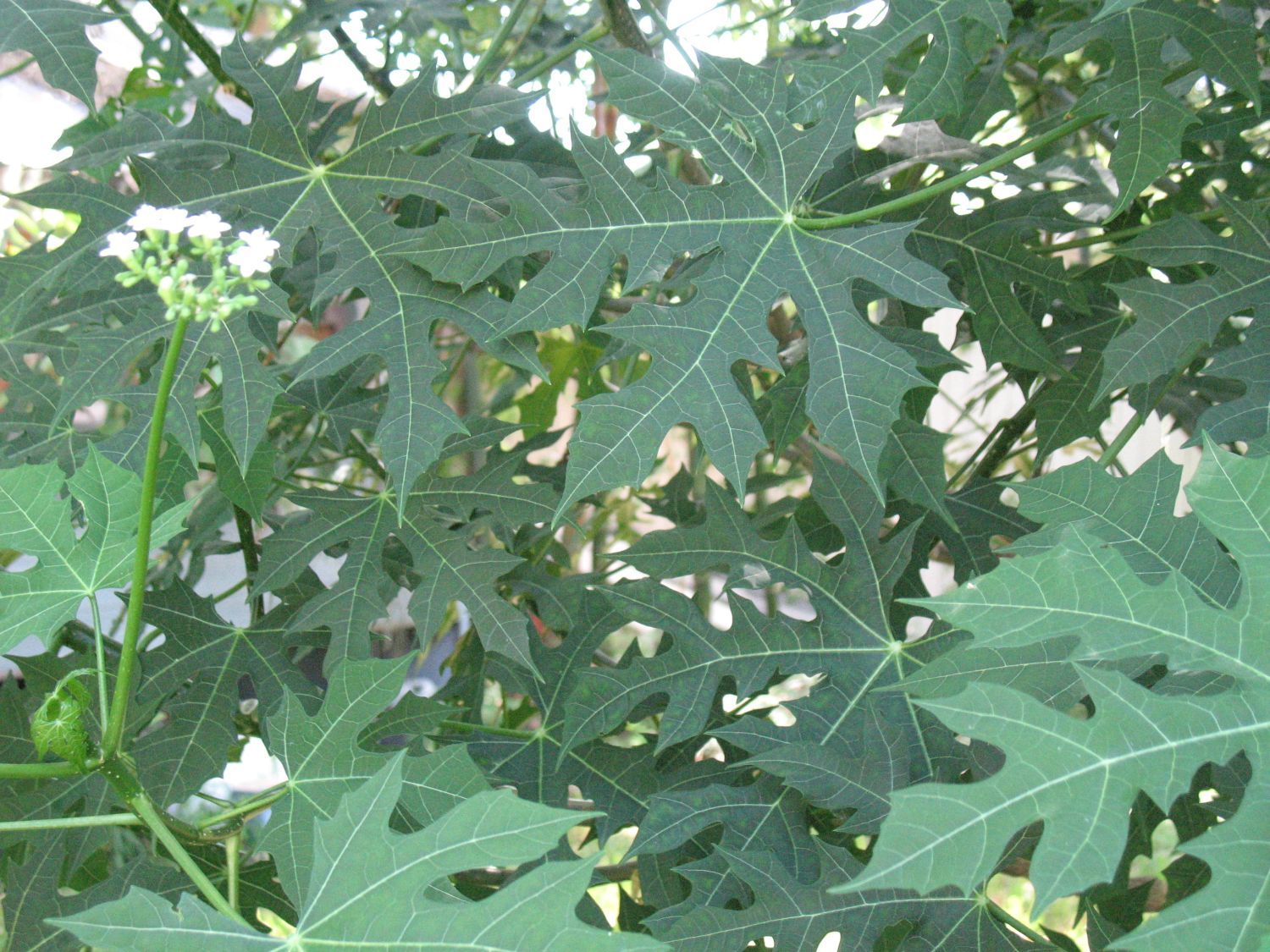
For those of us in colder climates, where chaya won't survive outside unprotected, it also does quite well in pots, as long as you keep it in a large enough pot. I typically start new branches in a 1-gallon nursery pot, and it can take them several weeks to months to become fully rooted. Be sparing in harvesting leaves for the first year of growth, as you want the new chaya to put most of its energy into growing a good root system.
Be aware that, before planting new cuttings in soil, you need to allow the cut ends to cure until the latex from the cut is completely dry; usually three or four days is a good bet. They CANNOT be rooted in a misting system, as they will rot, rather than rooting. Err on the side of less water, rather than more, until they are well established.
Also be aware that, if you place the pots directly on soil, without a plant tray or other impervious barrier, the chaya is likely to root aggressively into the ground, rendering it difficult if not impossible to move. That is how my first chaya branch from Bette managed to grow to six feet tall in its' original one-gallon nursery pot.
If that happens, all you need to do is to bend it over in opposite directions a few times, until you gain access to the roots, and cut them off as close to the bottom of the pot as possible, with a sharp knife, coping saw or shovel. Doing so will not hurt the plant, though clearly, it will need to be repotted or planted in the ground come spring, if not before.
After the first year, move the chaya into a much larger pot, preferably at least five to seven gallon, using a good quality potting soil mixed with sand or perlite for drainage. Although chaya can tolerate flooding for short periods, it is a member of the euphorbia family, and thus a true succulent, and will be much happier being kept a bit dry over a bit wet. Ideally water it when the soil is dry to the first joint of your finger. That is the best way to tell.
Once your chaya is a year or two old, you'll be able to harvest leaves on a regular basis, and enjoy it in all kinds of ways. One of my favorites was to mince it finely in the blender with water, drain it, then add it to an asparagus and artichoke dip that I make, for added nutrition and a little different taste. Chaya leaves are quite mild tasting, milder than true spinach, and they blend well with whatever you cook them with, whether meats, vegetables, soups or just as a side dish on their own.
I brought six potted chayas with me to Tennessee, all of which I still have, though I've potted cuttings and given them away to a number of people. Their growth rate here is nothing approaching that in Florida, as they spend the winter months inside, and though the room I keep them in has a bank of west-facing windows, it just isn't as warm or as bright as they were used to in our Florida back yard. I am hoping to put up a greenhouse in the near future which will enable us to grow them year-round again.
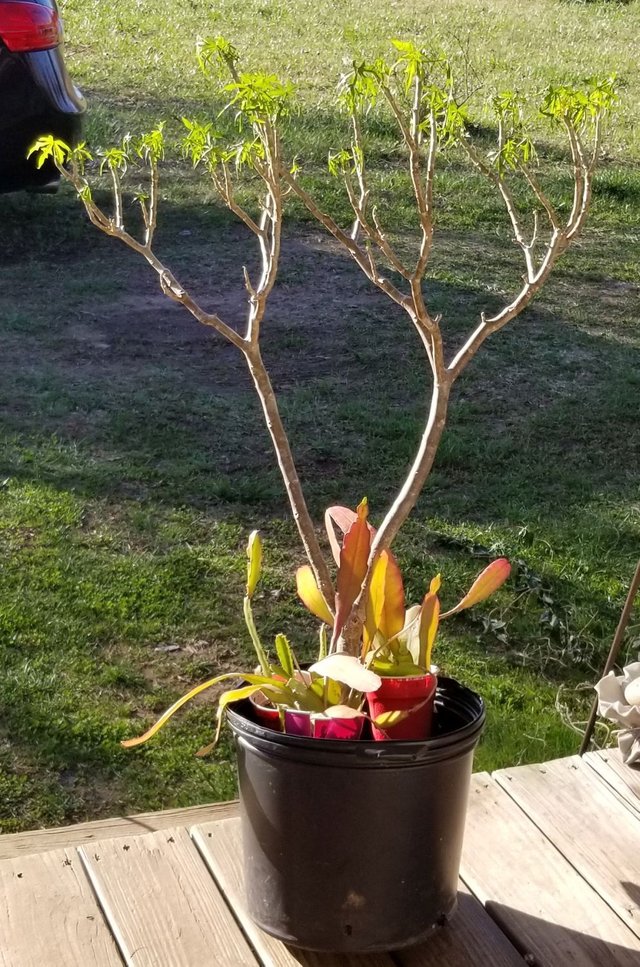
Here is one of my chaya bushes, which is in serious need of repotting, and is just beginning to leaf out again after winter. Unlike in Florida, here they lose most of their leaves in the winter, primarily I believe due to the lack of humidity in the studio, which is another reason why I think growing them in a greenhouse would be far superior to the way we are doing it now.
Additionally, they take up a LOT of room inside, which we could devote to other purposes once they have a permanent winter home.
The smaller plants around the base of the chaya are orchid cactus cuttings I rooted last season. I will be repotting them to sell within the next few days.
This first link is to an article I wrote several years ago, probably 2008 or 2009, which was originally published on one of my blogs, and picked up by www.CaribbeanChoice.com.
Why they filed it under “Belize” I have no idea, though presumably, being near the Yucatan, they have a lot of chaya there. The rest of the links are source material and additional information.
http://www.caribbeanchoice.com/belize/content.asp?article=1755
https://hort.purdue.edu/newcrop/proceedings1996/V3-516.html
https://www.drweil.com/diet-nutrition/cooking-cookware/cooking-chaya/
https://en.wikipedia.org/wiki/Cnidoscolus_aconitifolius
https://permaculturenews.org/2016/08/15/7-perennial-shrubs-trees-edible-leaves/
I will be writing about a lot of other multi-use plants we could all grow to improve our health, as well as our finances, by establishing another income stream.
Moringa and goji berries are next on the list. Stay tuned.
For #jerrybanfield, #tampabay, and anyone else living along the Gulf Coast, the desert Southwest, or elsewhere where freezes are rare, you owe it to yourselves to start growing chaya. It is a remarkable and beautiful plant, and you can potentially do a lot of good by giving rooted cuttings to those less fortunate.
For #reko, and others working with the homeless and less fortunate in the frozen North, it might be a great idea to get a group together to rent greenhouse or warehouse space, or even to build a greenhouse, to grow chaya with artificial lights and heating, as it is so prolific once it gets going that it will more than pay for its own upkeep, and again, you could give cuttings to those truly in need.
The Rocky Mountain Permaculture Institute has great plans for how to build and heat a truly workable four-season greenhouse in really harsh conditions. I'm editing this on my phone, so I don't have the link handy, but I'll post it later.
All words and images are my own.
Resteeming is welcome, you may link to my post from your own website or blog, and you may use excerpts and/or images as long as you credit me and link back to this post.
Please ask for permission, before using my work without linking to this post, as all rights are reserved.
Hey there gardener, I'm Oatmeal Joey Arnold, and I love your photos and I have a garden where I live near Seattle and saw a bunch of plants and bananas when I lived in Vietnam. I love spinach and I eat garlic each day and I love natural remedies.
Downvoting a post can decrease pending rewards and make it less visible. Common reasons:
Submit
Well then you and I are definitely two of a kind. ;-) I've love unusual edibles for decades, and I've both gardened and been into natural remedies for as long as I can remember.
And the one time I was in Seattle I loved it. We were only there for a few days, and spent most of that time in a class, but we'd love to go back sometime and get to know the area better.
Downvoting a post can decrease pending rewards and make it less visible. Common reasons:
Submit
How can we get more into gardening?
Downvoting a post can decrease pending rewards and make it less visible. Common reasons:
Submit
I'm doing it mostly with perennials, though we are having serious issues with our local deer, and need to fence them out more effectively. We'll be growing more annual crops this year than we have in the past, but again, much depends on how quickly we can get effective fences up.
I'll also be posting more on the varieties that have worked for me, and those I'm intending to try, based on what I've heard and read. Ultimately, I'll be including more audios and videos as well, for those who prefer those formats, as one of my goals for years has been to teach others how to grow their own food easily and inexpensively, even without a lot of space.
I've been saving seed for a couple of decades, and swapping with people around here for different heirloom seeds, so that I am growing more and more things that are perfect for our climate and growing conditions.
For example, while cherries have yet to work for us, because nurseries typically stock cherry trees grafted to rootstock that won't do well here; pears, blackberries and horseradish are no-brainer crops that anyone around here can grow easily.
Our thornless blackberries have produced bumper crops for the past two years, in large part because the deer don't bother with them, because we have literally massive patches of wild blackberries throughout our woods.
At this point, what I need above all is a greenhouse, which would solve the deer issue while providing protection against frost and freezes. Wish us luck.
Downvoting a post can decrease pending rewards and make it less visible. Common reasons:
Submit
My mom has a greenhouse and it helps. Love berries.
Downvoting a post can decrease pending rewards and make it less visible. Common reasons:
Submit
Me too.
One of our big unexpected scores was, about three years ago, a native black raspberry sprouted and started growing from under our covered front porch. My guess is that it was planted by a mouse or squirrel.
It doesn't root well from cuttings, but if a branch reaches the soil, it will burrow down and sprout, creating a new plant. Blackberries spread this way as well.
Anyway, this is on the northwest corner of the house, and shaded by the porch and a couple of big bushes, but it has still given us fruit every year.
I've now got half a dozen more plants that we've started from this one, ready to go into the ground, with which I want to create a living fence around our orchard.
Hopefully this will help to deter the deer from breaking the branches of our fruit trees. In any case, they should give us some yummy fruit, so it's all good.
Downvoting a post can decrease pending rewards and make it less visible. Common reasons:
Submit
Sounds like fun and like a constant war with Bambi hhehe.
Downvoting a post can decrease pending rewards and make it less visible. Common reasons:
Submit
Yeah, they're a pain in the *ss, but they're so pretty and sweet I can't stay mad at them. But I AM going to get them out of our orchard.
They can have the woods - there's plenty for them to eat there without messing with our fruit trees. ;-)
Downvoting a post can decrease pending rewards and make it less visible. Common reasons:
Submit